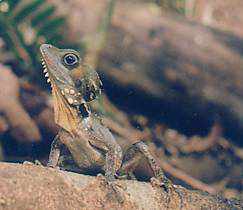Boyd’s Forest Dragon

Photo: Courtesy of Damon Ramsey
BSc.(Zool) Biologist Guide
Boyd’s Forest Dragon (Hypsilurus boydii)
Markings: - The forest dragon is very distinctive with large pointed scales on a crest behind the head, pinkish flat-topped conical scales on the cheeks and a deep mustard yellow pouch beneath the jaw line. It is an exquisite medium sized lizard coloured an olive brown, with brighter patches of yellow, black and white, spines, a dewflap and white 'stones' embedded on the cheeks
- Despite its ornate structures and bright colouration it is cryptic in its tropical rainforest environment where it camouflages well.
Habitat and Distribution: - It is only found in the rainforests of north eastern Queensland, restricted in area from just south of Cooktown, to the Atherton Tableland region and south to Paluma near Townsville.
- It spends most of its time in trees and due to its camouflage it is often very hard to see and thus tends to go unnoticed. However they can more easily be spotted basking in the sun on the sides of roads and walking tracks where it may be lying on the ground to absorb some of the heat radiating form the surface.
- Forest dragons are territorial with the larger male territory usually containing one or more small female territories. Sometimes lizards have one or two favourite trees within their territory to which they will regularly return. (Source: Environmental Protection Agency)
Diet: - Their diet consists of insects and other invertebrates with ants the most common prey item.
- They will also take beetles, grasshoppers and have a special fondness for earthworms. Although they may occasionally eat rainforest fruits, this seems to be rare. (Source: Environmental Protection Agency)
Size: - The forest dragon has a head and body length of about 15cm with its long tail adding another 30cm to total length.
Egg-laying/Mating: - Stormy weather in December has been shown to encourage mating and egg laying behaviour in Boyd's Forest Dragon.
- Mating attempts have been viewed on the forest floor with the larger male giving no attention to decorous behaviour.
- female dragons in the cooler uplands often move in search of open sunny spots, such as roads. They tend to sit on the roads, presumably using the warmth to help speed development of the eggs (a risky. habit ). Despite their fairly large size, forest dragons produce relatively small clutches, laying only one to six eggs at a time in a shallow hole (The Queensland Environmental Protection Agency).
- The breeding season is late spring and early summer. At this time Unfortunately upland dragons often lay them in warmer areas at the sides of roads where they are vulnerable to vehicles. Lowland dragons lay on the forest floor.
Viewing Opportunities: Additional Information: The Queensland Environmental Protection Agency Boyd's forest dragon belongs to a South-east Asian group of lizards, although our species (Hypsilurus (Gonocephalus) boydii) is endemic to the Wet Tropics region of North Queensland. The male has a home range of about 1000 square metres. Female ranges are slightly smaller. Home ranges of the same sexes do not overlap but larger male territories often contain one or more female territories. Movements within the territories vary with season with dragons travelling 100m or more during summer days but relatively little in winter. These lizards spend much of their time perching on the side of tree trunks just one or two metres from the ground waiting to ambush prey. They sometimes have favourite trees to which they will regularly return. The male is larger than the female and can be distinguished by its larger, blockier head. Both sexes have a large yellow dewlap below their chins which they can erect using a bone called the hyoid. The dewlap is used for displaying to each other and to scare off predators. The lizards mature at about 1-3 years of age. They may live for about five or ten years but this is uncertain. In general the forest dragon relies on its superb camouflage to escape predators. It will usually stay very still, only moving when it is sure it has been spotted. Then it slowly folds in its arms and legs and slides around the back of the tree, keeping the trunk between itself and its observer. The best way to spot a forest dragon is to carefully scan the sides of the trees at about head height, while slowly walking through the rainforest. Examine any large bump – it may well turn out to be a lizard. Sunlight is not always available in the rainforest; the thick canopy blocking most of it. Hence several lizard species have abandoned basking in favour of a lifestyle known as 'thermoconforming'. This is where the lizard's body temperature simply conforms to that of the air around it.
(This extra information was supplied courtesy of The Queensland Environmental Protection Agency)
Additional Boyd's Forest Dragon Photos
Additional Boyd's Forest Dragon Photos 2 |
